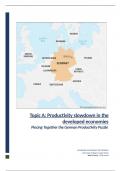Topic A: Productivity slowdown in the
developed economies
Piecing Together the German Productivity Puzzle
ECON0028: ECONOMICS OF GROWTH
University College London (UCL)
Word Count: 1528 words
, Introduction:
One of the most puzzling phenomena of the developed world, and subject of intense debate among
economists, is the productivity slowdown that started in the early 1970s (Weil, 2016a, p.288).
Productivity measures the efficiency of factors of production in producing a given level of outputs in
an economy (Krugman, 1994). In this essay, we present the productivity slowdown with a focus on
the specific causes and consequences for Germany, comparable to a sample of countries (France,
Spain, UK and USA), concluding with a policy suggestion for the German economy.
Describing the Productivity Slowdown:
Figure 1:
Source: Penn World Table (2021)
German productivity has followed wider trends of slower productivity growth among developed
countries, dubbed the era of ‘secular stagnation’ by Schmidt et al. (2021) since the 1970s. GDP per
hour worked approximately doubled between 1990-2019 but had grown over three times in the
previous 30 years (starting 1960) (Bergeaud, Cette and Lecat, 2016), demonstrating a sharp
slowdown in productivity growth.
One reason for the slowdown is lower efficiency in Germany. There is a large gap between the rate of
capital intensity and labour productivity (Figure 6).Increasing capital intensity implies that more
capital is being substituted for labour, i.e., automated. Given Germany’s large manufacturing sector
(Figure 9) (O’Neill, 2023), the elasticity of substitution between capital and labour has been large,
allowing for capital intensity to contribute 78% of GDP in 2015 (Bergeaud, Cette and Lecat, 2016).
However, if substitution occurs too rapidly (as in the case of Germany in Figure 6) or without
sufficient investment in human capital (e.g., via education and training), it can result in a mismatch
between the skills of the workforce and the needs of a capital-intensive economy. This mismatch can
lead to inefficiencies in the utilisation of resources in the economy and, as a result, a slowdown in
productivity.
While capital-per-labour is increasing, the marginal effect on labour productivity is lower, illustrating
a mismatch between capital and labour. Table 1 decomposes the productivity gap between the US
and Germany where German technology is negligibly higher than the US. However, despite the
closeness in technological advancement, the level of efficiency in Germany is 88% of the US for the
same technology (Table 1). Moreover, TFP has lagged relative to comparable countries for most of





